Giving bug-like bots a boost
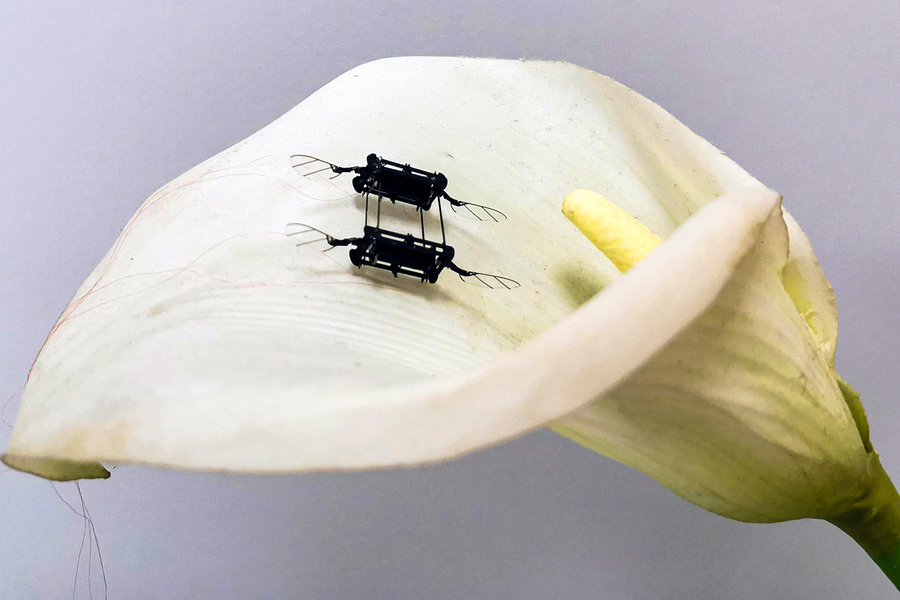
MIT researchers have pioneered a new fabrication technique that enables them to produce low-voltage, power-dense, high endurance soft actuators for an aerial microrobot. Credits: Courtesy of the researchers
By Adam Zewe | MIT News Office
When it comes to robots, bigger isn’t always better. Someday, a swarm of insect-sized robots might pollinate a field of crops or search for survivors amid the rubble of a collapsed building.
MIT researchers have demonstrated diminutive drones that can zip around with bug-like agility and resilience, which could eventually perform these tasks. The soft actuators that propel these microrobots are very durable, but they require much higher voltages than similarly-sized rigid actuators. The featherweight robots can’t carry the necessary power electronics that would allow them fly on their own.
Now, these researchers have pioneered a fabrication technique that enables them to build soft actuators that operate with 75 percent lower voltage than current versions while carrying 80 percent more payload. These soft actuators are like artificial muscles that rapidly flap the robot’s wings.
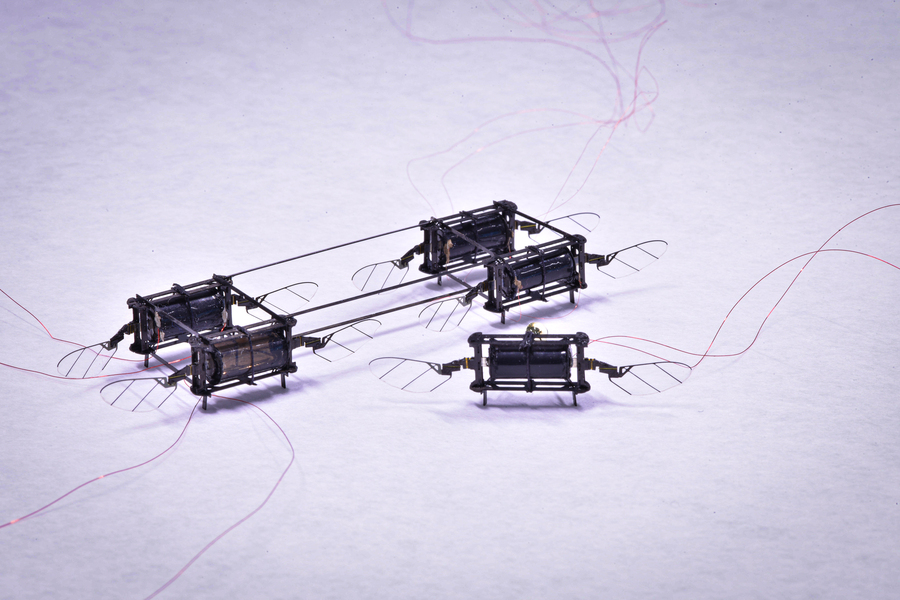
The artificial muscles vastly improve the robot’s payload and allow it to achieve best-in-class hovering performance. Image: Kevin Chen
This new fabrication technique produces artificial muscles with fewer defects, which dramatically extends the lifespan of the components and increases the robot’s performance and payload.
“This opens up a lot of opportunity in the future for us to transition to putting power electronics on the microrobot. People tend to think that soft robots are not as capable as rigid robots. We demonstrate that this robot, weighing less than a gram, flies for the longest time with the smallest error during a hovering flight. The take-home message is that soft robots can exceed the performance of rigid robots,” says Kevin Chen, who is the D. Reid Weedon, Jr. ’41 assistant professor in the Department of Electrical Engineering and Computer Science, the head of the Soft and Micro Robotics Laboratory in the Research Laboratory of Electronics (RLE), and the senior author of the paper.
Chen’s coauthors include Zhijian Ren and Suhan Kim, co-lead authors and EECS graduate students; Xiang Ji, a research scientist in EECS; Weikun Zhu, a chemical engineering graduate student; Farnaz Niroui, an assistant professor in EECS; and Jing Kong, a professor in EECS and principal investigator in RLE. The research has been accepted for publication in Advanced Materials and is included in the jounal’s Rising Stars series, which recognizes outstanding works from early-career researchers.
Making muscles
The rectangular microrobot, which weighs less than one-fourth of a penny, has four sets of wings that are each driven by a soft actuator. These muscle-like actuators are made from layers of elastomer that are sandwiched between two very thin electrodes and then rolled into a squishy cylinder. When voltage is applied to the actuator, the electrodes squeeze the elastomer, and that mechanical strain is used to flap the wing.

The rectangular microrobot, which weighs less than one-fourth of a penny, has four sets of wings that are each driven by a soft actuator. Credits: Courtesy of the researchers
The more surface area the actuator has, the less voltage is required. So, Chen and his team build these artificial muscles by alternating between as many ultrathin layers of elastomer and electrode as they can. As elastomer layers get thinner, they become more unstable.
For the first time, the researchers were able to create an actuator with 20 layers, each of which is 10 micrometers in thickness (about the diameter of a red blood cell). But they had to reinvent parts of the fabrication process to get there.
One major roadblock came from the spin coating process. During spin coating, an elastomer is poured onto a flat surface and rapidly rotated, and the centrifugal force pulls the film outward to make it thinner.
“In this process, air comes back into the elastomer and creates a lot of microscopic air bubbles. The diameter of these air bubbles is barely 1 micrometer, so previously we just sort of ignored them. But when you get thinner and thinner layers, the effect of the air bubbles becomes stronger and stronger. That is traditionally why people haven’t been able to make these very thin layers,” Chen explains.
He and his collaborators found that if they perform a vacuuming process immediately after spin coating, while the elastomer was still wet, it removes the air bubbles. Then, they bake the elastomer to dry it.
Removing these defects increases the power output of the actuator by more than 300 percent and significantly improves its lifespan, Chen says.
The researchers also optimized the thin electrodes, which are composed of carbon nanotubes, super-strong rolls of carbon that are about 1/50,000 the diameter of human hair. Higher concentrations of carbon nanotubes increase the actuator’s power output and reduce voltage, but dense layers also contain more defects.
For instance, the carbon nanotubes have sharp ends and can pierce the elastomer, which causes the device to short out, Chen explains. After much trial and error, the researchers found the optimal concentration.
Another problem comes from the curing stage — as more layers are added, the actuator takes longer and longer to dry.
“The first time I asked my student to make a multilayer actuator, once he got to 12 layers, he had to wait two days for it to cure. That is totally not sustainable, especially if you want to scale up to more layers,” Chen says.
They found that baking each layer for a few minutes immediately after the carbon nanotubes are transferred to the elastomer cuts down the curing time as more layers are added.
Best-in-class performance
After using this technique to create a 20-layer artificial muscle, they tested it against their previous six-layer version and state-of-the-art, rigid actuators.
During liftoff experiments, the 20-layer actuator, which requires less than 500 volts to operate, exerted enough power to give the robot a lift-to-weight ratio of 3.7 to 1, so it could carry items that are nearly three times its weight.
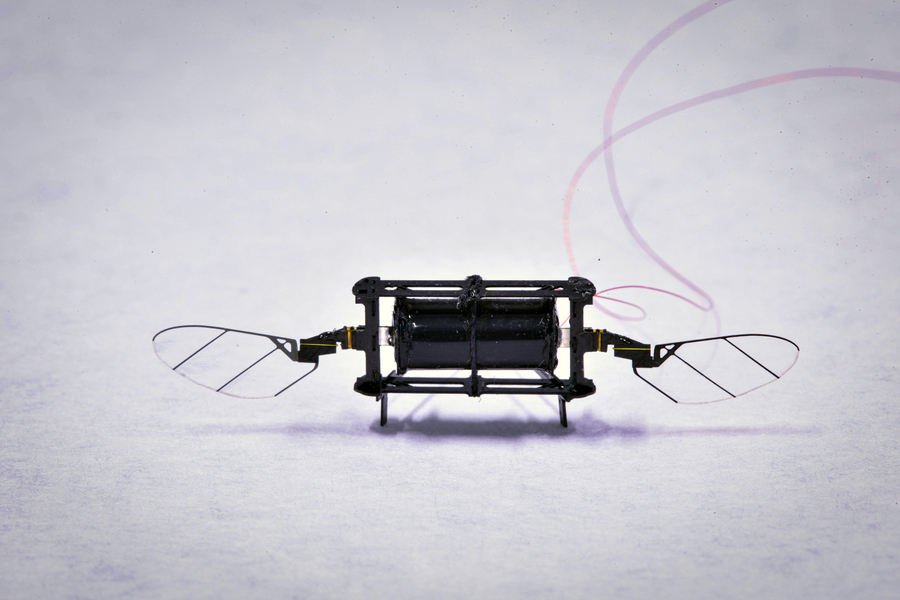
“We demonstrate that this robot, weighing less than a gram, flies for the longest time with the smallest error during a hovering flight,” says Kevin Chen. Credits: Courtesy of the researchers
They also demonstrated a 20-second hovering flight, which Chen says is the longest ever recorded by a sub-gram robot. Their hovering robot held its position more stably than any of the others. The 20-layer actuator was still working smoothly after being driven for more than 2 million cycles, far outpacing the lifespan of other actuators.
“Two years ago, we created the most power-dense actuator and it could barely fly. We started to wonder, can soft robots ever compete with rigid robots? We observed one defect after another, so we kept working and we solved one fabrication problem after another, and now the soft actuator’s performance is catching up. They are even a little bit better than the state-of-the-art rigid ones. And there are still a number of fabrication processes in material science that we don’t understand. So, I am very excited to continue to reduce actuation voltage,” he says.
Chen looks forward to collaborating with Niroui to build actuators in a clean room at MIT.nano and leverage nanofabrication techniques. Now, his team is limited to how thin they can make the layers due to dust in the air and a maximum spin coating speed. Working in a clean room eliminates this problem and would allow them to use methods, such as doctor blading, that are more precise than spin coating.
While Chen is thrilled about producing 10-micrometer actuator layers, his hope is to reduce the thickness to only 1 micrometer, which would open the door to many applications for these insect-sized robots.
This work is supported, in part, by the MIT Research Laboratory of Electronics and a Mathworks Graduate Fellowship.
Unconventional Space Robots

Credits: Marco Pavone
Lilly interviews Stephanie Schneider, a PhD candidate at Stanford working on unconventional space robotics. Schneider explains her work on Reachbot, a long-reach crawling and anchoring robot, which repurposes extendable booms for mobile manipulation. They discuss the challenges and exciting elements of robotic prototyping for low-gravity or otherwise unique environments.
https://youtu.be/0RqFgOHqz7E

Stephanie Schneider
Stephanie Schneider is a Ph.D. candidate in Aeronautics and Astronautics in the Autonomous Systems Laboratory at Stanford, working with Professor Marco Pavone. She received her BS in Mechanical Engineering from Cornell University in 2014. Stephanie’s research interests include real-time spacecraft motion-planning, grasping and manipulation in space, and adaptive control for autonomous robotics.
Links
- Download mp3 (41.7 MB)
- Subscribe to Robohub using iTunes, RSS, or Spotify
- Support us on Patreon
Mind-controlled robots now one step closer
Low-voltage, power-dense artificial muscles that improve the performance of flying microrobots
Robot-assisted System with Ensenso 3D Camera For Safe Handling of Nuclear Waste
Robot-assisted System with Ensenso 3D Camera For Safe Handling of Nuclear Waste
Investors warn Deep Tech founders about these 12 pitfalls
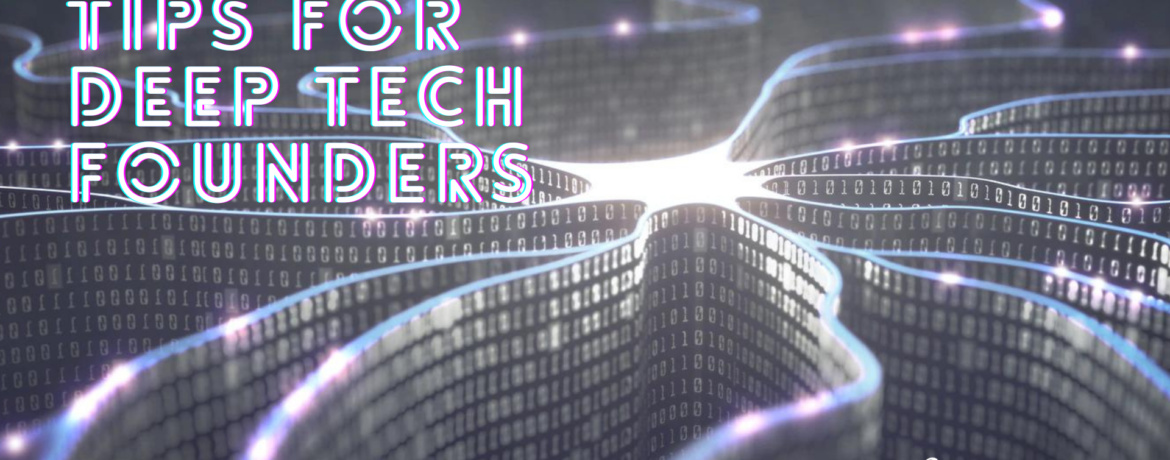
Firstly, what is Deep Tech as opposed to Tech or technology enabled? Sometimes Deep Tech is regarded as a science based startup, sometimes it is regarded as disruptive to the status quo, sometimes it is regarded just as slow and hard, capital intensive, with a long ROI horizon. Or as something that investors aren’t ready for yet. But the amount of money going into Deep Tech investing is increasing, and the pool of Deep Tech investors is increasing. One of the key points I made in a recent GIST Tech Connect Deep Tech panel is that most investors, including the most successful Tech investors are not able to invest seriously in Deep Tech startups because they lack the technical awareness and depth of commercialization experience specific to a Deep Tech startup. GIST or the Global Innovation in Science and Technology Network is the US State Department program to encourage and support global entrepreneurship.
In fact, if you do the research into the failure rates of some high profile Deep Tech startups, it seems that certain large funds have a much higher failure rate than others, so at best, their growth pathway is not compatible with Deep Tech startups. At worst, they are simply cherry picking some Deep Tech startups for their publicity value. Startups should always do their due diligence on investors and how they treat founders, particularly founders with similar startups.
Universities play a huge role in derisking, funding and commercializing Deep Tech startups but there is still a ‘Valley of Death’ in the transfer stages. And a Deep Tech startup can come out of any university but not all universities have real commercialization experience and a supportive startup ecosystem. Silicon Valley Robotics and Circuit Launch have provided a ‘halfway house’ for a lot of Deep Tech startups by providing affordable workspace with prototyping facilities and a startup ecosystem. But the first question I always ask entrepreneurs is if they have leveraged every advantage that their university connections can provide. Universities can provide greatly discounted lab space and testing facilities, also connections to scientific experts in most any field who can be leveraged as consultants and advisors.
The SBIR program, or the American Seed Fund, which is about a $4 billion non dilutive funding from the federal government in the form of R&D dollars, contracts and grants to small businesses and startups gives you the opportunity to derisk a lot of the technology very early on. You can really do a detailed scope and scan, and then couple that with the iCorps program and you get the opportunity to do deeper dives into customer discovery, to really understand if this is something that’s just a nice to have, or is it a real must have. Although the SBIR program is American based program, a lot of the countries around the world have been creating similar ones. A good example of that is EU Horizon 2020 grants.
Grants catalyze and do a certain amount to de-risk technology, extending the runway through non-dilutive funding and by creating a technology roadmap which validates the science as significant. Corporate venture funds or strategic investors also play an important role, alongside non-dilutive grant funding. Not only can they be a check, they can be a customer, they can be an advisor and a partner in the early prototype to manufacture stages. The best strategic investors play a huge role in helping Deep Tech startups succeed, because they need the technology you are creating.
Here’s a collection of tips for Deep Tech founders gathered from the GIST TechConnect Panel on Deep Tech with Nakia Melecio from Georgia Tech, Nhi Lê from WARF, Andra Keay from SVR and The Robotics Hub, G. Nagesh Rao from US Dept of State. Also tips from Six red flags that send investors running the other way by Sara Bloomberg, San Francisco Business Times. Quotes not attributed to other investors are my thoughts or recollections from the event.
Accelerator hopping
“When you start going from accelerator to accelerator looking for funding, then you’re doing it wrong. Accelerators only fund you to participate in their program. Their program and mentors are the real value.” Nhi Lê, WARF Accelerator
You also dilute your equity and become uninvestable.
Taking the first check, giving away too much equity in early rounds
Always negotiate terms. But don’t focus solely on the financials and at the risk of throwing away the less obvious value that a good investor can bring to you.
“Deep Tech startups may take longer to get to revenue than a traditional tech startup, so you need to think about grant funding as a source of revenue, and any contracts that help you develop part of your technology.” Nhi Lê, WARF Accelerator
Not budgeting for IP defense
“Companies often say that they’re investable because they have a patent, but they haven’t budgeted anything to defend it. Your IP is only as good as your ability to defend it. Universities play a great role in protecting and defending IP that they’ve licensed.” Nhi Lê, WARF Accelerator
Not having a plan for the whole journey
“When you go into your first funding meeting, you must be thinking about the long term journey, all the way to exit. It’s never going to be just one check, you’re growing a company.” G. Nagesh Rao, US Dept of Commerce
Not doing diligence on investors or accelerators
“Deep tech, especially at the leading edge, is usually expensive, so it’s critical to find the right path to commercialization at scale. Good investors speed up the process and lower your burn rate.” Michael Harries, The Robotics Hub
Have your potential investors brought similar startups to market? Having that experience can make the commercialization process much faster, and it’s critical to manage your resources effectively. Constant fundraising takes founders away from product development. Also, do your investors have patient capital? Or are they needing a rapid return on investment for their current fund? Don’t assume that a well known investor or accelerator guarantees you success, or even finding a good fit with their process.
Ignorance of basic financials
Overreaching on inventory, being unable to meet debts in a timely fashion, structuring the company poorly, all these things are cited by founders who’ve struggled.
Customer discovery never stops
“Focus on the customer and fall in love with the customer’s problem and you’ll never go wrong.” Nakia Melecio, Georgia Tech
Do it from the start, and never stop going to market. You can’t just outsource your business development to people with better sales skills, not until you know that pain points you’re solving for your customers and you can write the scripts for them.
Not doing the research, or using vanity metrics instead of strategy
“If a founder is estimating their market in the trillions of dollars they have either not done the research or they are just delusional.” Swati Chaturvedi, Co-Founder of PropelX
“Founders who are focused only on vanity metrics (growth rate and valuation) and not attuned to developing sound business models are a red flag.” Anurag Chandra, Fort Ross Ventures
Trying to skip steps
“Another red flag is trying to FOMO you into moving quickly. Not only is it bad for arriving at a sound investment decision, it’s an indication of how they do business with customers and partners (ie. not invested in building long term relationships). Anurag Chandra, Fort Ross Ventures
Misrepresentation or withholding data
“Investors can tell when you are avoiding details like actual product or customer development status and it may mean you are misrepresenting your business.” Caroline Winnett, Executive Director of Berkeley SkyDeck
Cofounder issues, not having a clear leader or not being open to feedback
“There needs to be agreement on who is acting as CEO, and everyone needs to be aligned on that. Another red flag is not being open to advice from experts.” Caroline Winnett, Executive Director of Berkeley SkyDeck
Being disorganized
“Founders should be responsive to requests for more information. It shows if they are organized and in the mindset to do a deal versus spin cycles.” Shruti Gandhi of Array Ventures
3D Medical image segmentation with transformers tutorial
Engineers develop a robotic hand with a gecko-inspired grip
Robot hand moves closer to human abilities
A new untethered and insect-sized aerial vehicle
Robotic Research Announces $228 Million Series A Funding Round to Scale Autonomous Technology Commercially
Youssef Benmokhtar: Digitization of Touch and Meta AI Partnership | Sense Think Act Podcast #9
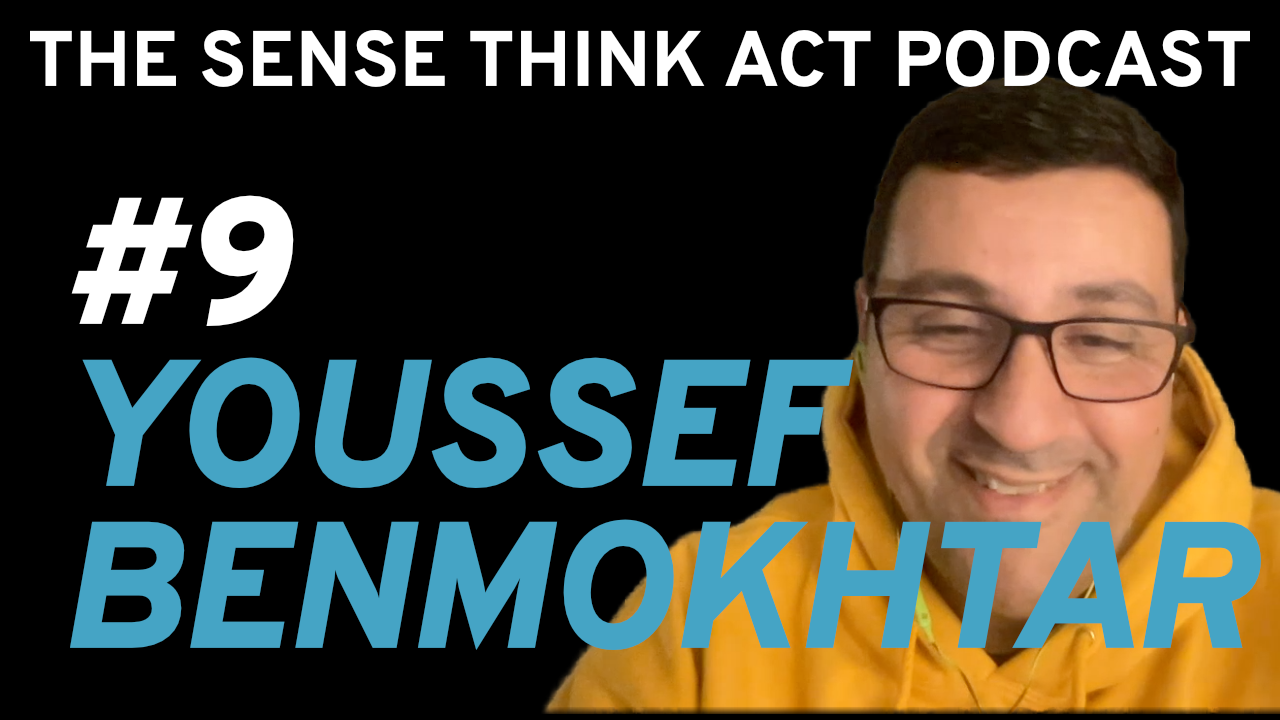
In this episode, Audrow Nash speaks to Youssef Benmokhtar, CEO of GelSight, a Boston-based company that makes high resolution tactile sensors for several industries. They talk about how GelSight’s tactile sensors work, GelSight’s new collaboration with Meta AI (formerly, Facebook AI) to manufacture a low cost touch sensor called DIGIT, on the digitization of touch, touch sensing in robotics, how GelSight is investing in community and open source software, and Youssef’s professional path in several industries.
Episode Links
- Download the episode
- Youssef Benmokhtar’s LinkedIn
- GelSight’s Website
- DIGIT’s open source page
- PyTouch library
Podcast info